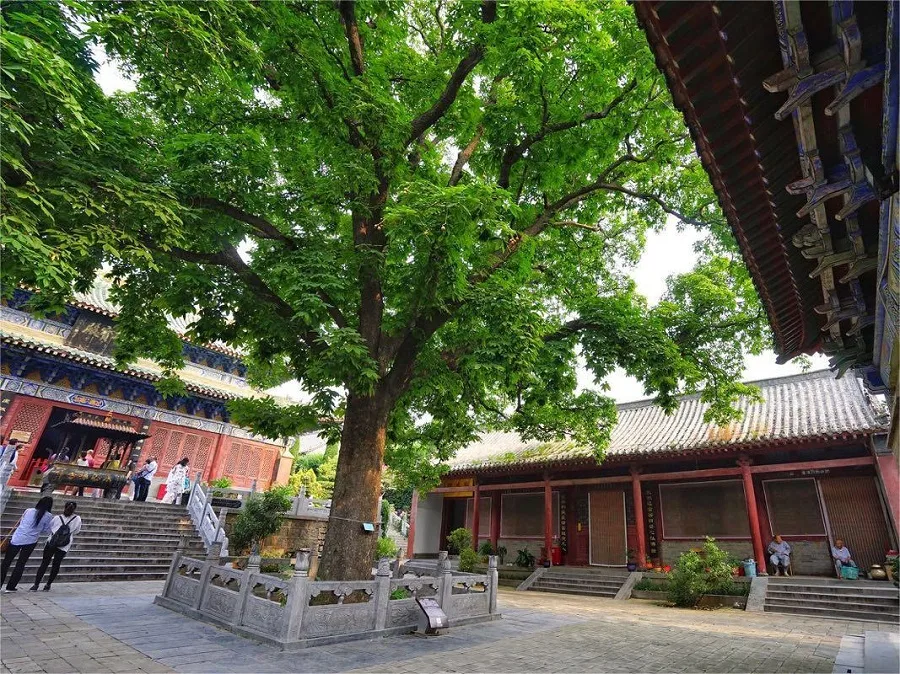Yongtai Monastery (永泰寺), established in the second year of the Zhengguang era of the Northern Wei Dynasty (521 AD), boasts a history spanning over 1400 years. Notably, it served as a place of spiritual cultivation for three princesses: Princess Zhuanyuan, daughter of Emperor Wen of the Northern Wei Dynasty, Princess Minglian, daughter of Emperor Wu of the Southern Liang Dynasty and a pioneering figure in Zen Buddhism for nuns, and Princess Yongtai, sister of Emperor Xiaoming of the Northern Wei Dynasty. It stands as the first nunnery constructed after the introduction of Zen Buddhism to China, making it a significant site in the history of Chinese Buddhism, particularly in the development of Zen Buddhism for nuns.
The monastery’s architecture consists of five main sections: the mountain gate, the Hall of Heavenly Kings, the Middle Buddha Hall, the Mahavira Hall, and the Huanggu Building, alongside auxiliary structures such as the Hall of Sangha and the Hall of the Sixth Patriarch. It is also the only place offering vegetarian meals in Songshan Mountain.
Table of Contents
- Basic Information
- Location and Transportation
- Highlights of Yongtai Monastery
- Vlog about Yongtai Monastery
- Other Attractions in Taishi Mountain
Basic Information
| Estimated Length of Tour | 1 hour |
| Ticket Price | 60 RMB |
| Opening Hours | 8.00 – 16.30 |
| Telephone Number | 0086-0371-62745000 |
Location and Transportation
Yongtai Monastery is situated on the western slope of Mount Taishi, approximately 11 kilometers northwest of Dengfeng City, Zhengzhou, Henan Province. It faces westward, overlooking the renowned Shaolin Temple. Yongtai Monastery is not directly served by public bus routes. However, due to its proximity to Shaolin Temple, visitors can conveniently combine visits to both sites.
Highlights of Yongtai Monastery
Ancient Pagodas

Perched on the hillside behind Yontai Monastery are several ancient pagodas, including the Yongtai Pagoda from the Tang Dynasty, the Main Pagoda of the Jin Dynasty, the Suren Pagoda from the Ming Dynasty, and the Wuzhi Putong Pagoda. These pagodas, with their graceful and elegant designs, add to the scenic beauty of the surroundings.
Of particular note is the Yongtai Pagoda, a single-story, eave-enclosed brick pagoda standing 24 meters tall. Its square-shaped base gradually tapers upward, culminating in a spire composed of lotus petals and multiple rings, showcasing exquisite craftsmanship and architectural beauty. Additionally, the monastery houses over 40 stone inscriptions and sculptures dating back to the Tang Dynasty, renowned for their intricate carvings and elegant calligraphy.
Ancient Trees

Within the monastery grounds, visitors can marvel at ancient trees such as the “Flagpole Tree” and the solitary ginkgo tree, known for its prolific fruiting. Notably, the monastery is also home to the “Shepherdess Tree,” immortalized in the film “Shaolin Temple,” where it served as the backdrop for scenes featuring a shepherdess tending her flock. Moreover, a 2000-year-old Saraca tree, brought to China from India by the Indian monks Sengupta and Zhu Falian in the 8th year of the Eastern Han Dynasty (AD 64), is another botanical treasure found within the monastery, symbolizing the enduring cultural exchange between China and India.







